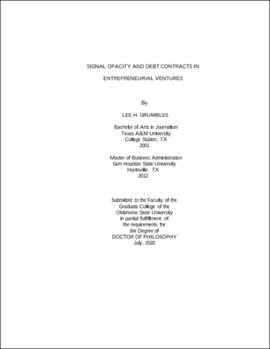| dc.contributor.advisor | Rutherford, Matthew | |
| dc.contributor.author | Grumbles, Lee H. | |
| dc.date.accessioned | 2021-02-22T22:24:03Z | |
| dc.date.available | 2021-02-22T22:24:03Z | |
| dc.date.issued | 2020-07 | |
| dc.identifier.uri | https://hdl.handle.net/11244/328603 | |
| dc.description.abstract | New ventures that are unable to fund expansion using internal equity or that prefer to maintain complete firm ownership may supplement existing cash flow by accessing external funds in the form of debt contracts. To overcome liabilities of newness and/or smallness, these firms send signals to external stakeholders intended to represent a sufficient level of legitimacy and worthiness of investment. Stakeholders attempt to overcome information asymmetry by focusing primarily on costly signals from high-quality firms that represent honesty, credibility, and commitment. However, many new ventures are unable to send these signals because they do not possess them. In this study, I examine signal opacity as specific signals that capture stakeholders' attention by alleviating the imbalance of information asymmetry yet are difficult to fully verify due to distortion and a signaling environment of high information verification costs. I also examine the decision-making strategy of the debt financier who utilizes heuristics in the form of expertise to make a probability judgment of credit worthiness based on opaque information presented by the new venture. As an extension of institutional and signaling theory, I theorize that new venture signals that are opaque and exist in a signaling environment of high information verification costs will have a positive effect on stakeholders' perceptions of legitimacy. I also theorize that the effect of signal opacity and information verification costs is moderated by stakeholder expertise, which is comprised of industry experience. | |
| dc.description.abstract | The findings of the qualitative portion were leveraged to validate the hypothesized variable composition of the signal opacity construct as well as to develop the survey instrument used in the quantitative analysis. The results of the main study are intriguing, finding that within environments of high signal opacity, stakeholders will perceive superior and poor new venture signals similarly when granting legitimacy judgments. Alternatively, the findings also show that within environments of low signal opacity, stakeholders will perceive superior and poor new venture signals differently when assessing legitimacy. Lastly, the findings do not support the notion that stakeholder experience is an important factor when making legitimacy perceptions based on these specific signals. | |
| dc.format | application/pdf | |
| dc.language | en_US | |
| dc.rights | Copyright is held by the author who has granted the Oklahoma State University Library the non-exclusive right to share this material in its institutional repository. Contact Digital Library Services at lib-dls@okstate.edu or 405-744-9161 for the permission policy on the use, reproduction or distribution of this material. | |
| dc.title | Signal opacity and debt contracts in entrepreneurial ventures | |
| dc.contributor.committeeMember | Moore, Curt | |
| dc.contributor.committeeMember | Davis, Robert Evan | |
| dc.contributor.committeeMember | Edwards, Bryan D. | |
| osu.filename | Grumbles_okstate_0664D_16820.pdf | |
| osu.accesstype | Open Access | |
| dc.type.genre | Dissertation | |
| dc.type.material | Text | |
| dc.subject.keywords | distortion | |
| dc.subject.keywords | new venture strategy | |
| dc.subject.keywords | signaling | |
| dc.subject.keywords | stakeholder legitimacy | |
| dc.subject.keywords | verification costs | |
| thesis.degree.discipline | Business Administration | |
| thesis.degree.grantor | Oklahoma State University | |
